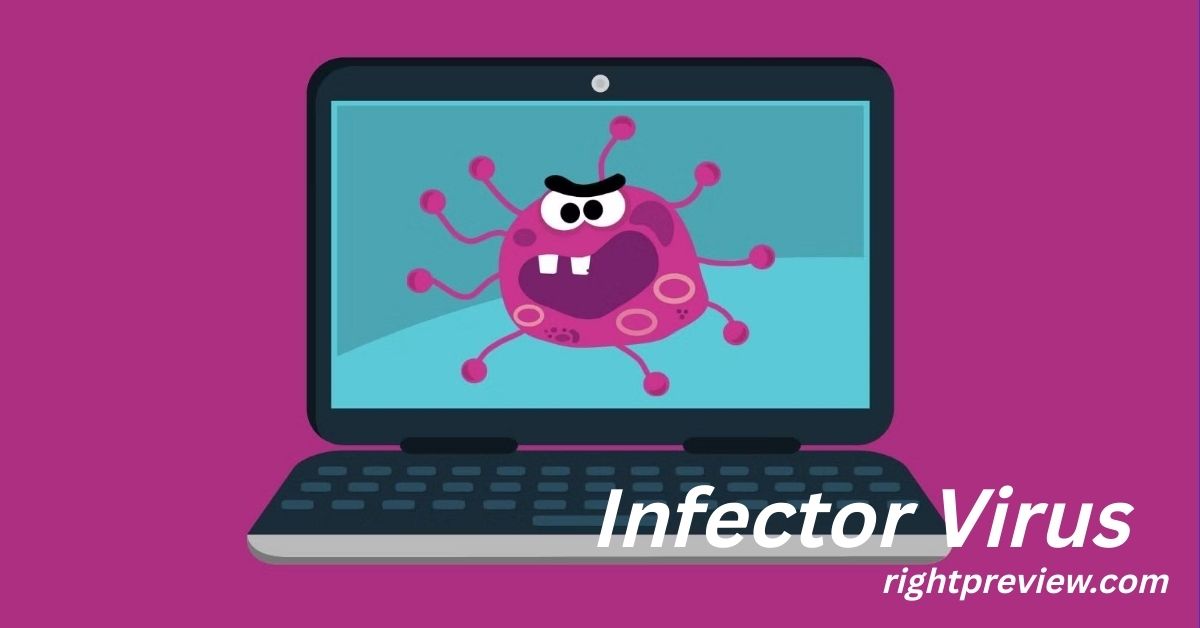The world of cybersecurity is filled with various threats, and one of the most damaging yet often overlooked types of viruses is the infector virus. Unlike traditional viruses that may only target files or cause general system malfunctions, the infector virus attaches itself specifically to executable files, making it highly dangerous. These viruses often operate stealthily, executing in the background and spreading to other files, which makes them particularly challenging to detect.
Understanding the mechanics of an infector virus is crucial for anyone who uses computers, whether for personal, professional, or academic purposes. This article will break down the concept of an infector virus, its behavior, the risks it poses, and most importantly, how to protect your system from these malicious programs.
What is an Infector Virus?: Understanding the Infector Virus: Overview and Functionality
An infector virus is a type of computer virus that attaches itself to executable files, such as .exe or .dll files, and modifies them to replicate itself. The virus usually becomes activated when the infected file is executed or run on the system. The infected file can then spread the virus to other files, causing widespread damage to the system or network.

Infector viruses are particularly dangerous because they hide within legitimate software and often go unnoticed by users until it’s too late. Unlike other types of viruses, such as macro viruses or boot sector viruses, an infector virus specifically targets and infects executable files. This type of virus is also more versatile, as it can affect almost any file type that is executed on the system
How Infector Viruses Work: How Does the Infector Virus Infect Your Files?
The operation of an infector virus begins when a user unknowingly opens or runs an infected executable file. Upon execution, the virus inserts itself into the system, attaches to other executable files, and begins replicating itself.
Once the virus attaches to an executable file, it modifies the file’s code to include its own malicious code. When the modified file is executed again, the virus becomes active and continues to spread to other files. The process is almost like a chain reaction, with each infected file having the potential to cause further damage by infecting other files on the system or network.
One of the key characteristics of infector viruses is their ability to remain hidden. Many of these viruses operate in the background, allowing them to stay undetected by users and antivirus programs. They may cause system instability or slow performance, but the symptoms may not be immediately linked to the virus, making it difficult to identify.
Also Read: 5starsstocks.com Nickel: Complete Guide for Investors in 2025
Types of Infector Viruses: Types of File Infector Viruses and Their Characteristics
There are several types of infector viruses that differ in their methods of attack and functionality. Here are some of the most common:
- Direct Action Infector Viruses:
- These viruses immediately activate once the infected file is opened. They typically infect specific files and don’t spread rapidly. Their primary purpose is to disrupt the file system by corrupting data or rendering the file unusable.
- These viruses immediately activate once the infected file is opened. They typically infect specific files and don’t spread rapidly. Their primary purpose is to disrupt the file system by corrupting data or rendering the file unusable.
- Resident Infector Viruses:
- Unlike direct action infector viruses, resident infector viruses take control of the system’s memory. They attach themselves to the operating system and infect any executable file that is opened. These viruses are more difficult to remove because they can replicate even after the initial infected file is deleted.
- Unlike direct action infector viruses, resident infector viruses take control of the system’s memory. They attach themselves to the operating system and infect any executable file that is opened. These viruses are more difficult to remove because they can replicate even after the initial infected file is deleted.
- Multipartite Viruses:
- Multipartite viruses are a combination of both direct action and resident infector viruses. These viruses can infect both the system’s memory and executable files, making them highly resilient and difficult to detect.
- Multipartite viruses are a combination of both direct action and resident infector viruses. These viruses can infect both the system’s memory and executable files, making them highly resilient and difficult to detect.
- Polymorphic and Metamorphic Infector Viruses:
- These viruses are designed to change their appearance or code every time they infect a new file. This characteristic makes it harder for antivirus programs to detect them, as the virus constantly morphs into a new form. Polymorphic and metamorphic viruses can also disguise their presence, often altering the file in such a way that it doesn’t resemble a virus.
- These viruses are designed to change their appearance or code every time they infect a new file. This characteristic makes it harder for antivirus programs to detect them, as the virus constantly morphs into a new form. Polymorphic and metamorphic viruses can also disguise their presence, often altering the file in such a way that it doesn’t resemble a virus.
Common File Infector Virus Examples: Real-Life Examples of File Infector Viruses
There are many examples of file infector viruses that have caused significant damage to systems over the years. Some of the most well-known include:
- Neshta Virus:
- One of the most notorious infector viruses, the Neshta virus primarily targets .exe files and spreads by infecting these files when they are executed. It was first discovered in 2003 and quickly gained attention due to its ability to infect executable files and evade detection by traditional antivirus software. The virus is particularly dangerous because it can remain hidden for long periods before manifesting its effects, causing major disruptions in the system.
- Neshta virus file infector Reddit discussions often describe how users have encountered this virus, highlighting its ability to disable antivirus software and manipulate system files.
- One of the most notorious infector viruses, the Neshta virus primarily targets .exe files and spreads by infecting these files when they are executed. It was first discovered in 2003 and quickly gained attention due to its ability to infect executable files and evade detection by traditional antivirus software. The virus is particularly dangerous because it can remain hidden for long periods before manifesting its effects, causing major disruptions in the system.
- CMJ Virus:
- This early file infector virus was known for spreading through infected .com files and was one of the first viruses to modify executable files. It was widely spread in the late 1980s and is considered one of the early examples of how infector viruses work.
- This early file infector virus was known for spreading through infected .com files and was one of the first viruses to modify executable files. It was widely spread in the late 1980s and is considered one of the early examples of how infector viruses work.
- Sasser Virus:
- While primarily a worm, the Sasser virus also displays behaviors similar to that of a file infector virus. It spreads by infecting executable files and exploiting system vulnerabilities.
- While primarily a worm, the Sasser virus also displays behaviors similar to that of a file infector virus. It spreads by infecting executable files and exploiting system vulnerabilities.
How to Protect Your Computer from Infector Viruses: How to Safeguard Your Computer from File Infector Viruses
The best defense against infector viruses is a combination of preventive measures and detection tools. Here’s how you can safeguard your computer:
Also Read: Moodle Gettysburg: The Complete Guide for Students and Faculty
- Use Reliable Antivirus Software:
- One of the most important steps in protecting your system is to install reputable antivirus software. Regularly updating your antivirus software is crucial to detect new viruses, including infector viruses.
- One of the most important steps in protecting your system is to install reputable antivirus software. Regularly updating your antivirus software is crucial to detect new viruses, including infector viruses.
- Be Cautious with Executable Files:
- Do not open .exe or .dll files from unknown sources. These files can often carry malicious code that can infect your system. Always verify the source before running any executable file.
- Do not open .exe or .dll files from unknown sources. These files can often carry malicious code that can infect your system. Always verify the source before running any executable file.
- Keep Software and Operating Systems Updated:
- Many viruses exploit vulnerabilities in outdated software. By ensuring that your operating system and applications are regularly updated, you minimize the risk of infection from file infector viruses.
- Many viruses exploit vulnerabilities in outdated software. By ensuring that your operating system and applications are regularly updated, you minimize the risk of infection from file infector viruses.
- Enable Firewall Protection:
- A firewall can help block suspicious traffic and prevent viruses from spreading to your system. It’s essential to have both network and application firewalls enabled.
- A firewall can help block suspicious traffic and prevent viruses from spreading to your system. It’s essential to have both network and application firewalls enabled.
- Backup Your Files Regularly:
- Regular backups ensure that, even if your system is compromised, you won’t lose important data. Store backups in secure locations, such as external drives or cloud storage, and make sure the backup files are not connected to the infected system.
- Regular backups ensure that, even if your system is compromised, you won’t lose important data. Store backups in secure locations, such as external drives or cloud storage, and make sure the backup files are not connected to the infected system.
The Impact of Infector Viruses on Systems and Data: How File Infector Viruses Affect Your Computer’s Performance
Infector viruses can have several damaging effects on your system:
- File Corruption: Infected files may become corrupted, making them unreadable or unusable.
- Data Loss: Some file infector viruses delete or alter data on the infected system, causing irreversible data loss.
- System Slowdowns: The virus can slow down system performance as it works in the background, consuming resources and processing power.
- Security Breaches: By infecting executable files, an infector virus can create backdoors for hackers, potentially leading to identity theft or the exposure of sensitive information.
Neshta Virus File Infector: The Neshta Virus: A Closer Look at This File Infector Virus
The Neshta virus stands out as a particularly challenging infector virus. It is known for infecting executable files, disabling antivirus software, and spreading to other systems through infected email attachments. The virus can remain dormant for long periods, making it difficult for users to notice. It also has the ability to modify system files and spread across networks, affecting multiple devices.
One of the most significant threats from the Neshta virus is its stealthiness. Often, by the time a user realizes their system is infected, the virus has already spread, causing extensive damage to files and systems. The Neshta virus file infector Reddit discussions are full of user experiences and methods for detecting and removing it, emphasizing the importance of timely virus detection and system monitoring.
File Infector Virus Prevention and Detection Tools: Top Tools for Detecting and Removing File Infector Viruses
- Antivirus Software: Popular options like Norton, McAfee, and Kaspersky are equipped with advanced features to detect and remove infector viruses.
- Malware Removal Tools: Specialized tools like Malwarebytes and Spybot Search & Destroy can provide additional layers of protection.
- Online Scanners: Free online virus scanners like ESET Online Scanner and Trend Micro can be used to scan specific files for infections.
Infector Virus in 2025: Emerging Trends and Risks: What’s Next for File Infector Viruses?
As technology advances, so too does the sophistication of file infector viruses. In 2025, we are likely to see even more advanced variants that can evade traditional antivirus software through machine learning, artificial intelligence, and polymorphic techniques. Staying ahead of these threats will require a continuous investment in cybersecurity tools and awareness.
Also Read: Tikcotech: The All-in-One App for Managing Apps, Playing Games, and Listening to Music
Conclusion: Stay Protected from Infector Viruses
Infector viruses remain one of the most dangerous types of computer threats due to their ability to infect executable files, spread silently, and cause significant damage. However, with the right tools, awareness, and preventive practices, you can protect your computer from these malicious programs. Regular updates, reliable antivirus software, and cautious behavior when handling executable files are all essential steps in safeguarding your system.
By staying informed and vigilant, you can ensure that your computer remains secure from file infector viruses and other types of malware.
FAQs About Infector Viruses
What is a file infector virus?
A file infector virus is a type of computer virus that attaches itself to executable files, such as .exe and .dll files. When these infected files are run, the virus becomes active and can spread to other files on the system. It can cause corruption of data, slow down system performance, and potentially result in security breaches.
How do file infector viruses spread?
File infector viruses typically spread when infected files are shared or executed on other systems. They can propagate through email attachments, malicious downloads, or network sharing. When the infected file is opened or executed, the virus attaches to other executable files, allowing it to spread further.
What are some examples of file infector viruses?
Some well-known examples of file infector viruses include the Neshta virus, the CMJ virus, and the Sasser virus. These viruses have infected systems in the past by attaching themselves to executable files and spreading across networks.
How do I protect my computer from infector viruses?
To protect your computer, make sure to use updated antivirus software, avoid opening suspicious .exe or .dll files from untrusted sources, regularly update your operating system and software, and enable firewall protection. It’s also important to back up your data regularly and avoid downloading files from unfamiliar websites.
Is the Neshta virus still a threat in 2025?
While the Neshta virus is less active today, older viruses like Neshta can still pose a threat, especially on systems that haven’t been updated or properly secured. It’s important to ensure that your antivirus software can detect and remove outdated malware threats.
What tools can detect file infector viruses?
To detect file infector viruses, use trusted antivirus software like Norton, Kaspersky, McAfee, and Malwarebytes. Additionally, specialized tools like Spybot Search & Destroy and online scanners such as Trend Micro can help identify and remove these types of viruses.
What is the best antivirus software for file infector viruses?
The best antivirus software for protecting against file infector viruses includes Norton, Kaspersky, McAfee, and Bitdefender. These programs offer robust virus protection, real-time scanning, and regular updates to detect the latest threats.




